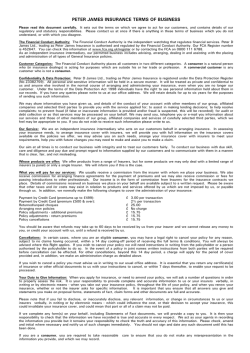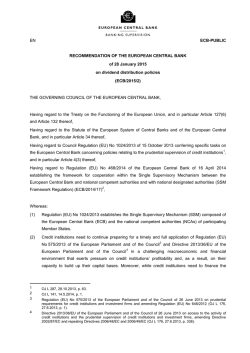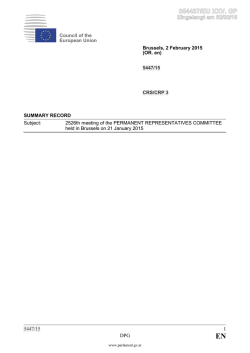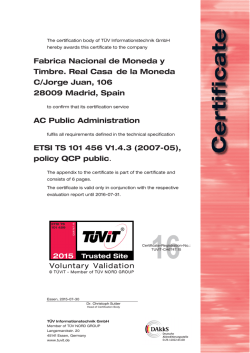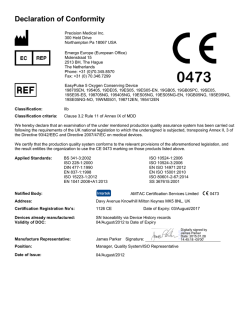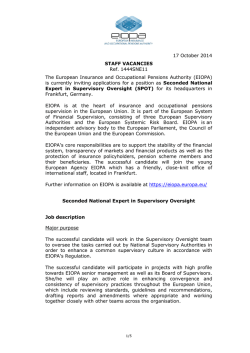
stocktaking and challenges of the eu financial services
European Parliament public hearing Brussels 16 June 2015 STOCKTAKING AND CHALLENGES OF THE EU FINANCIAL SERVICES REGULATION 1. Consumer protection: avoiding overlap and duplication •• Issue: work on individual legislative texts has led to overload and duplication, as numerous legislative texts will ultimately apply to an individual sales process. •• Challenge: to consider the comprehensive legislative landscape when developing EU legislation. •• Objective: develop a set of rules that avoids duplication and overload for the benefit of consumers and insurers alike. The focus of regulation should ensure that consumers are provided information that is of a high quality and relevant, rather than just a high quantity of information. Unfortunately, this is not the path that the EU is on today. Disclosure requirements (including duplications) from EU legislation applicable to the sales of insurance-based investment products TODAY: 75 TOMORROW: 147 Sales rules +388% IMD 2 (35) PRIIPs Regulation (27) Product disclosures +330% Sales rules IMD 1 (9) Product disclosures Life Directive (20) Solvency II Directive (39) Solvency II Directive Distance Marketing Directive (29) Distance Marketing Directive (29) E-Commerce Directive (17) E-Commerce Directive (17) Note: Based on the online sale of an insurance-based investment product by a broker. The IMD 2 disclosure requirements are based on the European Parliament’s text. © Insurance Europe www.insuranceeurope.eu Duplicative requirements from EU legislation applicable to the sales of insurance-based investment products IMD 2 Duplicative requirements on: Duplicative rules Advice Conflict of interest for insurance PRIIPs Sales rules IMD 2 PRIIPs chapter Disclosures of costs and charges IMD 1.5 Duplicative rules PRIIPs Regulation Disclosure of similar information Duplicative rules Product disclosures Solvency II Directive Solvency II Directive Distance Marketing Directive E-Commerce Directive Note: Based on the online sale of an insurance-based investment product by a broker. © Insurance Europe www.insuranceeurope.eu 2. Prudential regulation: Solvency II The original intention of Solvency II was to develop a principle based, modern, risk based prudential regime for insurers to replace an out-dated Solvency I. •• Issue: Solvency II has transformed from a principle-based regime to better reflect the risks of a company, into a detailed rule book that is over 3 000 pages long and, at times, highly descriptive. It also now, in some areas, does not reflect the business model of insurers. •• Objective: to ensure that the principle of proportionality is safeguarded as well as insurer’s ability to take risk from society, individual clients and invest with a long term-perspective. •• Challenge: all different layers and levels have to be taken into consideration when assessing the impact of financial services legislation, the overall timeline for implementation is too short, and a review is only foreseen by 2018. •• Opportunity: Capital Markets Union initiative provides possibility to address some of the issues. 3. Developments at international level •• Fact: At this time, three separate capital standards are in various stages of development at international level: •• a basic capital requirement (BCR); •• a higher loss absorbency (HLA) requirement for systemic insurers; and •• an international capital standard (ICS) for internationally active insurance groups. Finalisation of these three standards is foreseen by 2016 (ie at roughly the same time Solvency II is implemented in Europe), which Insurance Europe considers to be ambitious. •• Issue: •• The development of international insurance standards might impose changes to Solvency II and limit the legislative “margin of manoeuvre” for EU legislators. •• It is essential that European representatives who participate in negotiations at international level •• speak with one voice; and •• base negotiations on a transparent mandate. •• Challenge: It is currently unclear whether an EU “negotiating” mandate exists and what it consists of. Therefore, it is unclear what Europe supports, if all European representatives support the same thing and what will ultimately be implemented. •• Objective: In Insurance Europe’s view, it is critical that European representatives negotiate on the basis of a clearly defined mandate and defend key outcomes of the Solvency II package during international negotiations. 4. EIOPA and the European Supervisory Authorities (ESAs) The insurance industry strongly supports having a dedicated and independent insurance supervisor represented by EIOPA. Insurance Europe acknowledges the important role of EIOPA in dealing with the technical aspects of European insurance regulation through regulatory technical standards (RTS) as well as its considerable expertise in doing so. At the same time, Insurance Europe believes that the outstanding review of the ESAs should be to address issues that have been identified (eg governance, oversight). In particular, it must be ensured that all levels reflect and support the implementation of the initial political decision taken by the Council and Parliament. 5. Transposing banking regulation in insurance without sufficient tailoring In the aftermath of the financial crisis, a significant number of reforms have been introduced by international, European and national policymakers as a response to problems in the banking sector. Banks and insurers need differentiated and specific regulatory frameworks that fully reflect the profound differences between the business models and risk profiles of the two industries. Insurers should be regulated in line with their long-term business model, recognising their ability to match assets and liabilities and to invest in illiquid assets. This would enable the insurance sector to offer reasonable products and provide safety to future pensioners rather than shifting the entire risk on them. Find out more at www.insuranceeurope.eu and follow us @InsuranceEurope on Twitter. © Insurance Europe, June 2015
© Copyright 2026



